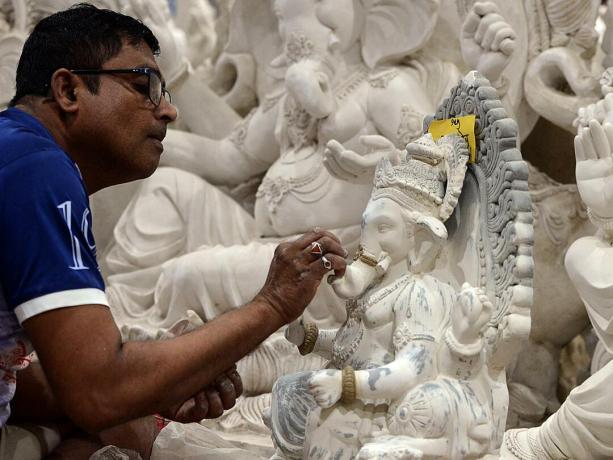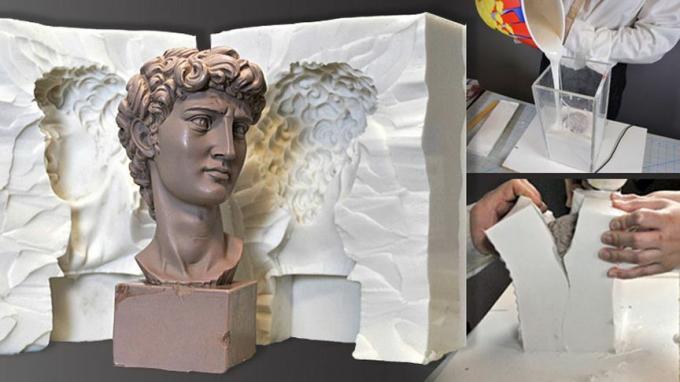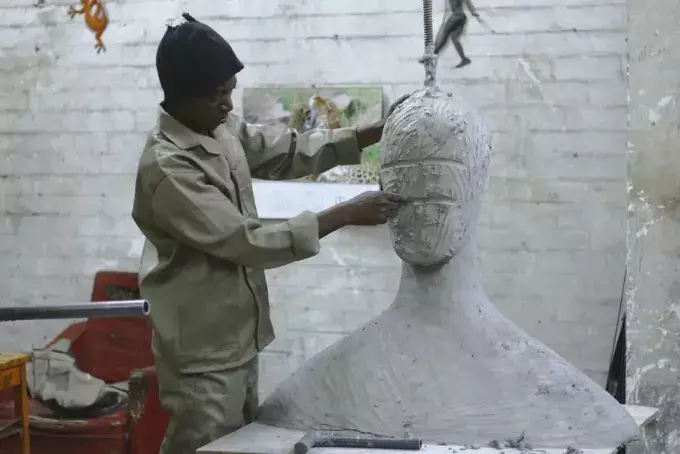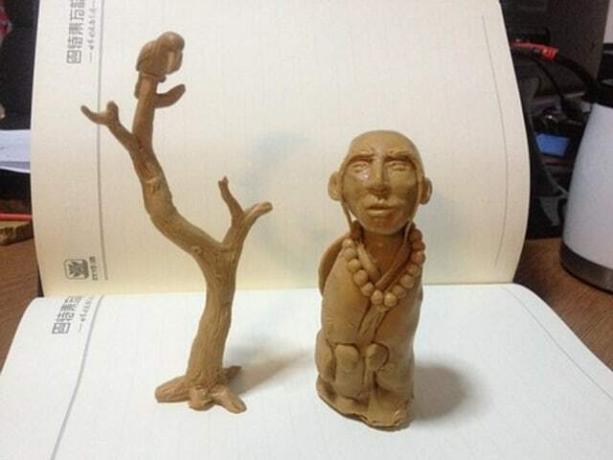Sculpture Techniques and Materials
Loading...
Sculpture which is a man-made 3-dimensional object is a work of art that has various functions. Not only one, the technique of making sculpture consists of many ways, from carving, butsir, printing to casting using certain materials.
Sculpture makers can imitate various forms, such as animals, people, buildings, flowers and cultural objects. The following is a complete explanation of the technique for making sculptures, the materials used and examples of sculptures.
List of contents
Types of Statues Based on Their Functions

The works of art that are judged to be pure are distinguished by categories, one of which is based on function. Here are the types of statues seen from their uses:
1. Miniature
The definition of miniature refers to a type of sculpture which is an imitation of an object in a smaller form than the actual object. Miniatures are useful for showing entire buildings, parts of buildings, statues or other objects so that they are easier to observe.
2. Monument
Furthermore, a monument is a type of statue that is made to commemorate something important and has historical value. It can refer to heroes, historical places or heroic events or events that deserve to be remembered.
3. Decor
The definition of a decorative statue is a type of statue that is used as a decoration or ornament to beautify or highlight a place. Statues as decorations can be placed indoors or outdoors.
4. Symbol of Worship
There are certain religions that use statues as sacred and meaningful objects. Therefore, statues as symbols of worship are made for worship at religious events.
Read: Fine Art Exhibition
Materials in Sculpture Pembuatan

In general, the materials for making sculptures are divided into 4 categories, namely soft, medium, hard and printed materials.
a. Soft Material
As for what is meant by soft material, it is a material that is soft and not hard so that it is very easy to shape it into a statue as desired. Examples of soft materials for creating sculptures are clay, soap, wax and plasticine.
The technique of making sculptures from soft materials is called butsir. In short, the technique is done by reducing or adding materials until the statue is formed beautifully.
b. Medium Material
Next, certain statues are also made using medium materials. That is, the type of material whose characteristics can be said to be balanced between hard and soft. Examples of materials currently in the making of sculptures include mahogany, waru wood, randu wood and sengon wood.
c. Hard Material
Judging from the name, it is clear that hard material is a type of material for making sculptures that is not soft and solid so it is difficult to change shape. Although hard materials are more difficult to form, sculptors can still produce satisfying works of art.
Examples of hard materials commonly used to make sculptures are ironwood and teak wood.
d. Print Material
For those who want a faster manufacturing process, then consider using printed materials. This type of printed material is fairly easy to use because the sculptor only needs to print it according to the desired shape of the statue.
Generally, printing materials include gold, cement, gypsum, sand and silver.
Read: Definition and Examples of Fine Art
Sculpture Technique
Advertisement
There are at least 6 techniques for making sculptures, namely chisel, print, cast, welding, butsir and assembling techniques.
1. Chisel

In making sculptures, chiseling is the oldest technique that requires very high precision. The technique of making sculptures uses hard materials such as teak and stone.
Basically, the chisel technique is done by reducing the material for making sculptures without being able to be patched or added with other materials. The sculptor must master the sculptural technique very well to produce the perfect shape and quality of the sculpture.
The process of sculpting the statue is assisted by chisels and hammers so that the results of the carving are neater. In addition, the sanding process is also carried out so that the final result of the statue is smoother and more beautiful.
2. Print

Making sculptures with printing techniques relies on a mold that has a certain shape. Compared to the chisel, the printing technique process is faster and easier. However, the shape of the resulting sculpture is usually not as unique as the sculptures.
The materials used to make sculptures from molds are soft materials. In addition to printing, the final process carried out also includes simple carving and sanding so that the results are better.
Generally, there are 3 types of molds for making sculptures, namely:
- Print High. This type of mold has a high size and an embossed surface;
- Flat Print. Flat molded shapes have a flatter surface and are not too tall;
- Print In. Called deep print because the mold used is concave so that the inner surface. Embossed effects are also produced when using the deep printing technique.
3. Cor

Just like molded sculpture, cast technique also requires sculpture molds that can usually be used many times. The difference is, the technique of making cast statues generally uses materials that are not soft, namely gold, silver, bronze or cement.
If using a metal type, then the material must be melted first before being put into the mold of the statue. Molds can also be custom made according to the buyer's order. The 2 casting techniques that are often used include:
- This method is a sculpture-making process that incorporates the materials into different molds. Generally, there are 2 pairs of molds that are put together and used repeatedly;
- Disposable. This method is a sculpture-making process that only uses 1 mold and is not used repeatedly. Usually, disposable molds have unique and intricate designs.
4. welding

Sculptures are also made with a welding technique that uses a special welding machine. In short, this technique is done by combining several materials to form the desired sculpture. Incorporation with a welding machine is necessary because the materials used are usually hard.
Examples of materials for making sculptures using welding techniques are iron, metal and silver. Sufficient electric power is also required to keep the welding machine running during the making of the sculpture.
5. Items

The technique of making butsir sculpture is a way of making sculptures using soft materials such as clay or gypsum. Sculptures are made by adding or subtracting materials until the statue is finished as desired.
Making sculptures with the grain technique requires precision and patience as does the chisel technique. Later, the finished statue will be dried in the sun to harden and sprayed with paint or varnish to make it look more beautiful.
6. Assembling

You must have heard of the Garuda Wisnu Kencana statue, right? The statue that stands majestically in Bali was apparently made using the assembling technique. The definition of assembling technique is a way of making sculptures by assembling or assembling several components into one.
So, parts or components of the statue are made separately, then put together into a complete statue. The material used can be clay, wax or wood.
Read: Elements of Fine Arts
Sculpture Example

There are many statues that are very famous and iconic at home and abroad. Here are some examples of statues that are often found as icons of a place or in historical buildings:
- Ceramic crafts which include jugs, jars, flower vases and other 3-dimensional shapes as decorations;
- Reliefs that are often found on the surface of the walls of temples or monuments to describe an important event;
- Mosaic;
- Carving in the form of animals, flowers, plants or humans;
- The Welcome Statue in Jakarta;
- Garuda Wisnu Kencana statue in Bali;
- Dirgantara statue in Jakarta;
- The Pancasila Sakti Monument located in East Jakarta;
- the Proclamation Monument located in Central Jakarta;
- Statue of Martha Christina Tiahahu in Ambon.
It is necessary to know both the technique of making sculptures and examples of the materials used, because the choice of technique affects the type of sculpture material. The purpose of using the statue is also important to consider so that the design can adjust.
X CLOSE
Advertisements
ADVERTISEMENT
X CLOSE
